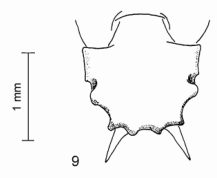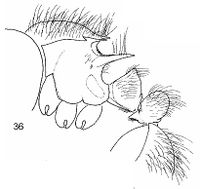Meranoplus diversoides
| Meranoplus diversoides | |
|---|---|

| |
| Scientific classification | |
| Kingdom: | Animalia |
| Phylum: | Arthropoda |
| Class: | Insecta |
| Order: | Hymenoptera |
| Family: | Formicidae |
| Subfamily: | Myrmicinae |
| Tribe: | Crematogastrini |
| Genus: | Meranoplus |
| Species: | M. diversoides |
| Binomial name | |
| Meranoplus diversoides Schödl, 2007 | |
The species is found throughout Queensland and southernmost Northern Territory.
Identification
Schödl (2007) - M. diversoides is closest to Meranoplus diversus but easily separated by the less prominently developed clypeal structure.
Keys including this Species
Distribution
Latitudinal Distribution Pattern
Latitudinal Range: -24.88333333° to -24.88333333°.
| North Temperate |
North Subtropical |
Tropical | South Subtropical |
South Temperate |
- Source: AntMaps
Distribution based on Regional Taxon Lists
Australasian Region: Australia (type locality).
Distribution based on AntMaps
Distribution based on AntWeb specimens
Check data from AntWeb
Countries Occupied
| Number of countries occupied by this species based on AntWiki Regional Taxon Lists. In general, fewer countries occupied indicates a narrower range, while more countries indicates a more widespread species. |

|
Estimated Abundance
| Relative abundance based on number of AntMaps records per species (this species within the purple bar). Fewer records (to the left) indicates a less abundant/encountered species while more records (to the right) indicates more abundant/encountered species. |

|
Biology
Castes
Worker

| |
| . | |
Nomenclature
The following information is derived from Barry Bolton's Online Catalogue of the Ants of the World.
- diversoides. Meranoplus diversoides Schödl, 2007: 388, figs. 36, 37, 70, 83 (w.) AUSTRALIA (Queensland, Northern Territory).
- Type-material: holotype worker, 10 paratype workers.
- Type-locality: holotype Australia: Queensland, Tambo Airport, 24.x.1979 (R.H. Mew); paratypes with same data.
- Type-depositories: SAMA (holotype); ANIC, NHMW, SAMA (paratypes).
- Distribution: Australia.
Unless otherwise noted the text for the remainder of this section is reported from the publication that includes the original description.
Description
Worker
Holotype. TL 6.10, HL 1.65, HW 1.90, FC 1.35, CS 1.78, SL 0.89, SI1 47, SI2 50, PML 1.15, PW 1.50, PMD 1.68, PMI2 112, ML 1.43, PSL 0.68, PTLL 0.48, PTLH 0.66, PTDW 0.56, PPLL 0.43, PPLH 0.68, PPI 63, PPDW 0.56, PT/PP 100.
Mandible with three teeth. Clypeus in full face view not exceeding anterolateral frontal corners, medially bidentate, medial dentate section with slight upward flexion, sunk into prolonged lateral frontal projections, with additional wrinkles or carinulae. Head distinctly wider than long (CI 115), preoccipital lobes bulbously rounded, rear margin of head concave. Frontal carinae distinctly sinuate and translucently margined anteriorly, distinctly narrower than head width (FI 141), anterolaterally extended into narrowly rounded projections exceeding clypeal fork. Antennal scrobe in lateral view surpassing middle of length of head, irregularly transversely carinulate in posterior half, with additional shagreening, ill defined near posterior section of head. Genae and ventrolateral sides of head rugose, posterior lateral corners of head reticulate. Compound eyes relatively small (EL 0.29, REL 0.17, with 17 ommatidia in the longest row), situated distinctly in front of middle of lateral sides of head, dorsal ocular margin not reaching ventral margin of antennal scrobe.
Promesonotum markedly wider than long (PMI 130), concealing lateral sides of mesosoma and propodeal declivity, translucently margined to a greater extent. Propodeal declivity above middle of its length with two long slender, in dorsal view feebly diverging slightly arcuated lateral spines.
Petiole higher than long (PTI 72) in profile broadly triangular, with anterior face straight and unsculptured, posterior face convex, distinctly and regularly costate. Postpetiole in profile dorsally nodiform, distinctly tapering towards base, with ventral medium sized tooth, rugose throughout.
First gastral tergite entirely microreticulate, basally with fine longitudinal costulae. Dorsum of head longitudinally costulate with additional rugulae and only few transverse meshes, behind level of eyes reticulate, interspaces with faint microsculpture. Promesonotal shield coarsely rugoreticulate. All dorsal surfaces with pilosity of decumbent curved hairs and longer more or less erect ones.
Color dark brown to brown, with the gaster and appendages brighter.
(n = 10). TL 5.80-7.10, HL 1.41-1.76, HW 1.61-1.82, FC 1.26-1.49, FI 128-142, CI 111-120, CS 1.51-1.90, SL 0.79-0.93, SI1 45-49, SI2 49-52, PML 1.07-1.38, PW 1.40-1.65, PMI 120-131, PMD 1.53-1.88, PMI2 109-116, ML 1.25-1.63, PSL 0.53-0.80, PTLL 0.41-0.53, PTLH 0.59-0.75, PTI 69-72, PTDW 0.56-0.68, PPLL 0.41-0.48, PPLH 0.63-0.78, PPI 61-67, PPDW 0.53-0.68, PT/PP 96-110, EL 0.24-0.31, REL 0.16-0.19, with 14-17 ommatidia in the longest row.
Type Material
- Holotype, worker, Tambo, Queensland, Australia, 24°53′0″S 146°15′0″E / 24.883333°S 146.25°E, Mew,R.H., South Australian Museum.
- Paratype, 8 workers, Tambo, Queensland, Australia, 24°53′0″S 146°15′0″E / 24.883333°S 146.25°E, Mew,R.H., South Australian Museum.
Etymology
The name refers to the close relationship to M. diversus.
References
- Schödl, S. 2007. Revision of Australian Meranoplus: the Meranoplus diversus group. Memoirs of the American Entomological Institute. 80:370-424.
